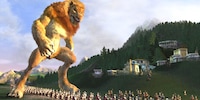
Background information
"Populous", "Black & White" and beyond? The evolution of the god simulation
by Kim Muntinga

Half-Life 2 is one of the most important games ever. A new documentary marking its 20th anniversary provides unique insights, explaining how an intern saved Valve from bankruptcy and why Episode 3 was never released.
Half-Life 2 begins the same way its predecessor both ended and started. The mysterious G-Man murmurs in his iconic voice, saying that you, Gordon Freeman, are needed again. Seconds later, the crowbar-wielding researcher who single-handedly stopped an alien invasion in Half-Life finds himself on a moving train.
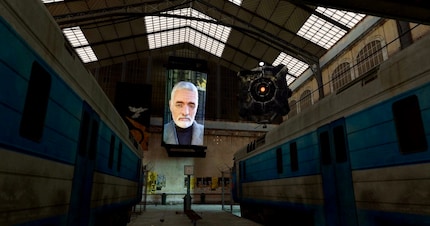
You don’t have time to think about how you got here, you’ve just reached the end of the line. You leave the train and find yourself in a station concourse, where you’re immediately photographed by a drone. A bearded man welcomes you to City 17 from a gigantic monitor. Right next to it, a Metro cop in a gas mask-like helmet gruffly shoves a commuter into a pile of suitcases. The parallels to George Orwell’s Big Brother are unmistakable.
Photographer Viktor Antonov drew inspiration from the iconic train station at Paris-Austerlitz. It’s one of the oldest stations in the French capital, providing the perfect backdrop to start an epic adventure that remains unforgettable even twenty years later.

Half-Life 2 was launched on 16 November 2004. To celebrate the anniversary, Valve has released a two-hour documentary. It was produced by the same team that usually interviews game studios under the name Noclip.
Numerous developers have their say in the documentary, including Valve boss Gabe Newell. He remembers how enormous the pressure was to produce a follow-up to the surprise hit Half-Life. «We didn’t want to be a one-and-done kind of company. So now we had the terrifying obligation to our customers and to our fans to somehow advance our game design skills, our technology all needed to level up for the second game.»
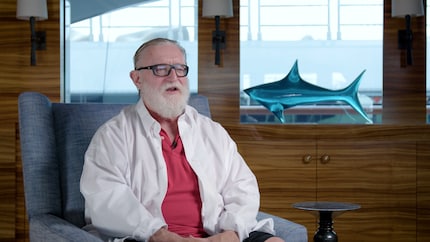
Valve spent the first two years experimenting with all kinds of ideas. «The first two years we tried a lot of things,» story writer Marc Laidlaw recalls. This included three new alien races – such as warriors, insects and spies – and four major cities such as Prague, Jerusalem, Chicago and Los Angeles. They also sketched out an Arctic base, another under water, an icebreaker and an aeroplane crashing into a high-rise building. «We cut that right after 9/11,» says Laidlaw.
In the end, Prague served as a template for City17. However, several Valve employees cut their teeth on the Borealis icebreaker. In the end, the level was cancelled because the ship offered too little space. The unfinished level can be seen for the first time in the documentary.
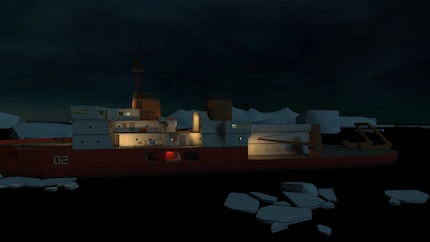
On a personal level, there was a reunion with old acquaintances in Half-Life 2. As Gordon again remains silent in the second part, it was all the more important that the people he meets on his adventure have plenty of character.
The team decided to bring back survivors from Half-Life 1. First among them lovable Barney, who’s evolved from security guard to resistance fighter and helps Gordon escape. Dr Isaac Kleiner is also back. The somewhat scatterbrained but warm-hearted professor has developed a teleporter, which he tests out with his tamed headcrab.
But perhaps the most important ally is and remains Alyx Vance, who actively helps Gordon with her robot pet Dog. Back in the day, she enchanted numerous young adults with her design. Not surprising, her near-realistic eyeballs took around nine months to develop.
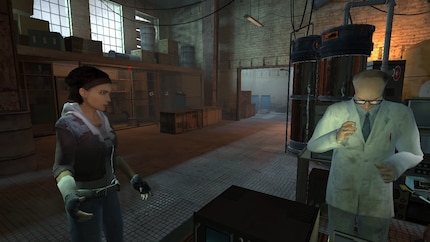
Valve took a pragmatic approach to the faces of protagonists. Instead of using actors or a dub cast, they scanned employees, old school friends or a sales clerk from the nearest supermarket. Barney’s face belongs to Scott Lynch, the COO of Valve. Dr Klein, on the other hand, is actually an accountant who worked for a company below Valve. A few developers met him in the elevator one day. «We came back with our morning coffee and that’s when we saw him. We looked at each other and immediately knew. That’s him, the scientist type,» says producer Bill Van Buren with a laugh.
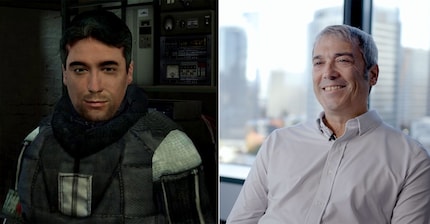
Dhabih Eng wanted to give new impetus to the design of Gordon Freeman’s suit. «I thought, I’ll make this my thing now.» Dhabih had only recently joined Valve. «The suits were reminiscent of stillsuits from Dune. Lots of black, belt buckles and latex. Gabe just said: what is this? Why isn’t it orange? Why are you replacing this iconic part of the character?» So Dhabih started all over again. The result was Gordon’s now-iconic combat suit.
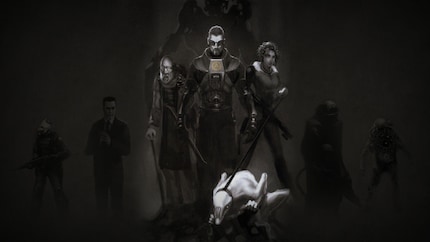
The designers also broke new ground when it came to the actual game. The documentary reveals depressing, dark scenes from City17. The sky is bathed in an eerie green, the streets are poorly lit and the colour palette consists of grey, black and dark green. «But then we thought that players would hardly want to spend 20 to 40 hours in a dark, dystopian world,» says designer Marc Laidlaw, explaining the move away from this concept. However, the feeling of living in a surveillance state persisted.
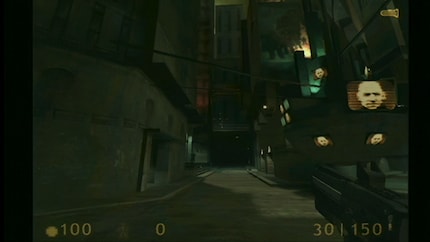
Something that every Half-Life 2 fan remembers is the funky physics. The new Havoc physics engine allowed for revolutionary interactions. It starts with simple things, like TVs you can throw out of a window through glass panes. Or wooden boards that can be «realistically» destroyed.
In many places, physics are also used to solve puzzles. One of the first to be implemented is the washing machine. To raise a ramp for your inflatable boat, you need to put enough weight on the suspension of a crane holding the ramp so you can drive over it. The idea came about because the developers wanted to give the players a breather after the relentless attacks from a combat helicopter in the canal section.
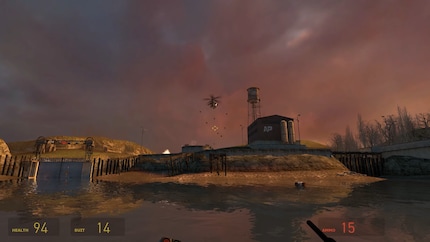
The fun really starts when Alyx hands Gordon the Gravity Gun. Originally, it was only intended as a developer tool. You can use it to grab small and medium-sized objects and fling them around. Nowhere is this more relevant than in Ravenholm. The legendary level is reminiscent of a horror game with its many alien zombies and dark atmosphere.
Originally, this section was to follow later in the game. But after developing the Gravity Gun, it was brought forward. «I enjoyed working on Ravenholm the most. A shortage of ammunition forces the player to rely on physics,» says designer Steve Bond. That’s why there’s an explosive barrel around every corner in Ravenholm, which you can catapult at monsters. There are also traps, such as suspended vehicles that you can send crashing down or rotor blades that cut zombies in two.
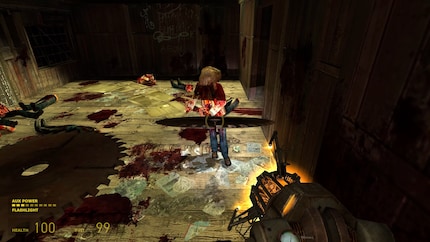
But nothing is more satisfying than the saw blade. You’ll find it in the very first room in Ravenholm – stuck in the severed torso of a corpse, which promptly falls to the floor when you pull it out. With the Gravity Gun, saw blades become deadly projectiles, making them perhaps the most fun toy in the whole game.
Getting the mass of objects right is crucial for the physics games to work and feel real. A flying drone reacts differently to being hit by a crowbar than a wooden crate. A problem for the developers was to put the mass of objects in the right proportion. «Mass is just a number and means something different to everyone,» says designer Robin Walker, explaining the dilemma.
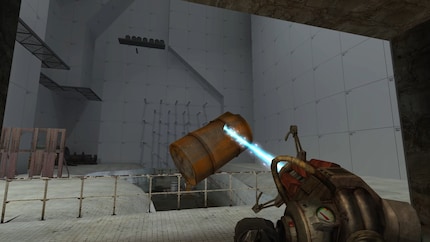
His coworker David Speyrer finally found a list of objects and masses online, implementing them in the game. «If you looked at an object afterwards, it said something like 100, bracket, racehorse. And because it was a logarithmic curve, it went from bread box to paint pot to space station. Even to the moon. There were lots of discussions, like: do you think it’s closer to a racehorse or a space station?» Robin says with a laugh.
Half-Life 2 was presented to the media for the first time at E3 2003. The physics demonstrations caused plenty of astonished faces. Visitors queued for hours to play the demo – including The Sims creator Will Wright and Nintendo guru Shigeru Miyamoto. The team knew then that they were on the right track. However, some major stumbling blocks were still to follow.
At the time of Half-Life 2’s development, Valve was a different company than the megacorporation that’s now raking in billions thanks to Steam. The first Half-Life, as well as Counter Strike and Team Fortress were published by Sierra. In 1998, Vivendi bought the company and with it the worldwide publishing rights – but only for retail products. A crucial detail, because Vivendi licensed Counter-Strike to cyber cafés, which were booming at the time. Young gamers competed all day long as terrorists or counter-terrorists.
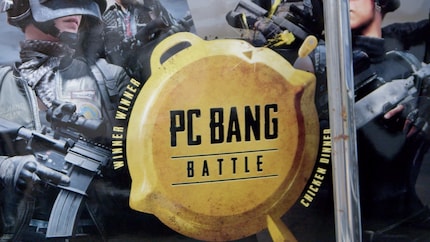
Valve let Vivendi know that these licences weren’t part of their contract and filed a lawsuit. The whole thing was followed by a year of tough negotiations where Valve reclaimed the trademark and digital distribution rights. «We must’ve struck a nerve with some people. Vivendi decided to declare a third world war,» says COO Scott Lynch, describing the situation at the time.
The lawsuit was initially in Valve’s interest, with some early minor successes. This prompted Vivendi to make a U-turn. With a new renowned law firm, they suddenly took a much more aggressive course. «They filed a counterclaim, which ranged from the termination of previous contracts to the takeover of all Half-Life trademark rights and halting the planned Steam launch,» said the lawyer responsible Karl Quackenbush. Vivendi also listed Gabe and his then-wife in the counterclaim. Vivendi wanted to run both Valve as well as the people behind it out of business.
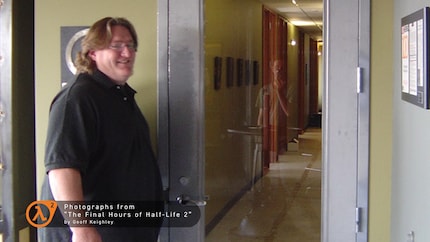
Karl has a clear opinion on this approach: «It was a really bad tactic. I don’t know of any other case where something like this has happened.» But it was promising. Gabe had invested almost his entire fortune in Valve and the development of Half-Life 2. «The company was close to bankruptcy. I was near bankruptcy. But we went all in.» Everyone knew the roles: Valve was David, Vivendi was Goliath. «Publishers were used to being able to intimidate developers,» Gabe notes.
As if the lawsuit wasn’t chaotic enough, the next low blow followed in September 2003: Half-Life 2 was leaked online. A young German hacker had gained access to Valve’s servers and downloaded wide-ranging data as well as the source code for the eagerly awaited game. It didn’t take long for an unfinished but playable version to end up on the internet. It spread like wildfire.
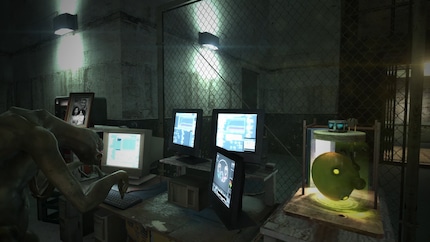
«I still remember Gabe walking past my desk and saying: ’Turn off the PC. I think we’ve been hacked.’ All I could think was: ’What?’» Designer Adrian Finol wasn’t the only one who was stunned. Developer Charlie Brown also felt as if someone had punched him in the stomach. «Usually people would ride around the office on scooters and Gabe would hum ditties. Suddenly everything went quiet. It was really creepy. The game would determine whether the company went under or not. We didn’t know whether we’d have to look for new jobs.»
While the authorities began their investigation, Valve asked the community for help in tracking down the hacker. He seemed to feel the increasing pressure, since he finally contacted Gabe personally. «I was furious, but in the end we came up with a plan. We told him that he was obviously very familiar with security and that he should come meet us.» The FBI would arrest him on arrival in the USA. But before he could take off, he was caught by the German police.
Even though it was a frustrating time for the Valve team, the leak had no consequences for Half-Life 2 apart from a later release date. Pressure of a somewhat different kind built up in that regard.
Valve wanted to sell games directly to consumers. However, there was a big push against this. «Whenever we told people that, yes, you’ll be able to offer software over the internet, they thought it’d never happen.» According to Gabe, 99 per cent of the companies they spoke to shared this view. The retail trade would never allow it, and users wanted physical games.
The decision to make Steam mandatory not only for the digital version of Half-Life 2, but also for every copy sold in stores, led to scepticism even among veteran employees. Contrary to the traditional Valve mantra that everyone should have a say, Gabe put his foot down: «Yes, that’s what we’re doing now.» And that was that. Steam was launched on 12 September 2003, one year before Half-Life 2.
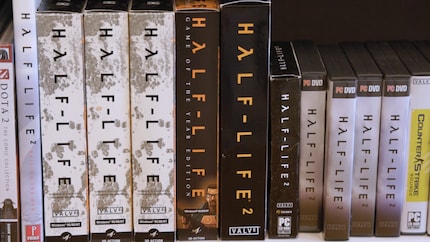
However, the sword of Damocles called Vivendi continued to dangle over the ambitious Steam plans and the promising launch of Half-Life 2. The company used all means at its disposal to put Valve out of action. In response to Valve’s request to know exactly what Vivendi was doing in South Korean cyber cafés, the company sent millions of documents. It was mostly useless emails and food orders that had nothing to do with the lawsuit. As if that wasn’t enough, the documents were written in Korean. Valve needed something incriminating, so they had no choice but to fight their way through it. The task was left to an intern who spoke Korean. «They knew that we had to spend a lot of money to find the needle in the haystack. That, or we’d give up. But suddenly, we found that needle in the haystack,» Gabe says.
The smoking gun was found in an e-mail between two high-ranking Vivendi managers: «Hey, we destroyed the Valve documents, just like you asked.» Vivendi rejected these accusations of destroying evidence on the grounds that it was a translation error. Attorney Karl Quackenbush asked the intern for an affidavit attesting his translation skills, whereupon he explained that Korean was his mother tongue and that he had a university degree in Korean linguistics. For Karl, it was one of the best moments of his career. «I’ve handled countless court cases, but I’ve never seen anything like this. Every so often you might be able to suspect but not prove destruction of evidence, but we had it in writing. I’d really never seen that before.» The rest was a formality. The judge ruled in Valve’s favour and Vivendi had to admit defeat.
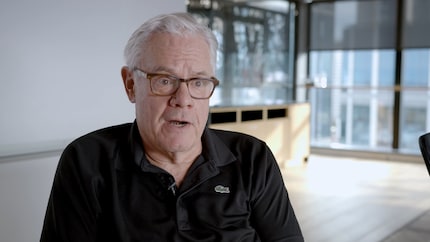
So, nothing stood in the way of a Half-Life 2 launch. Despite much grumbling, the Steam obligation didn’t diminish the game’s success. The long development time had paid off. However, the team also knew that things couldn’t go on like this. If the next game took another six years just to flop, the whole company would be at stake. To counteract this, they looked to publish episodic content with alternating teams every year or every six months. But their ambitions quickly grew out of proportion.
Episode 1 was more extensive than planned, and the next episode followed suit. But neither fans nor Valve were really happy with the result. «Players liked them less than Half-Life 1 and 2. And they took longer than planned: «We asked ourselves whether we were solving problems or simply taking a sidestep,» says developer Jay Stelly.
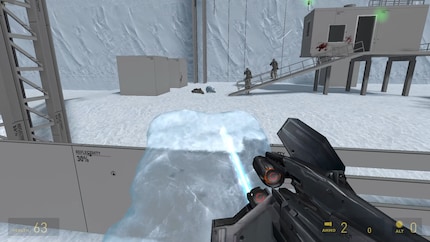
The last episode was to top everything that had gone before. It was set in the Arctic. An Ice Gun was the newest experimental weapon. A gameplay snippet revealed for the first time in the doc shows how you could erect protective walls in front of you or glide through your surroundings like the Silver Surfer. Enemies could also be frozen. The Blob was one new enemy. Instead, it ended up being used as a colour in Portal 2. It could split when it slid through objects, and if you lured it over a grid floor, it would fall through. Despite impressive concept art and ideas, Episode 3 was never completed. One decisive reason was the team responsible being pulled away to help with Left 4 Dead. When they finally returned, they found that too much time had passed to continue developing the final episode.
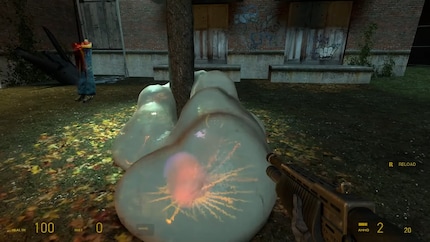
«Personally, I was disappointed that I’d reached the extent of my knowledge. I didn’t know how Episode 3 could’ve raised the bar.» However, the designers and developers don’t really mourn the open end of Half-Life. Jay sees it this way: «We created Left 4 Dead 2 and Portal 2 instead. Otherwise the players would’ve had to do without something else.» Even today, Valve is a relatively small company with an estimated 350 employees – and not all of them develop games. But there are undoubtedly a few more of those in the pipeline. The Half-Life universe is also likely to go on.
If you feel like digging up part two again, you can look forward to minor improvements delivered by Valve for the anniversary. Or you can be patient and wait to play the raytraced version, which is also in the works.
As a child, I wasn't allowed to have any consoles. It was only with the arrival of the family's 486 PC that the magical world of gaming opened up to me. Today, I'm overcompensating accordingly. Only a lack of time and money prevents me from trying out every game there is and decorating my shelf with rare retro consoles.
Interesting facts about products, behind-the-scenes looks at manufacturers and deep-dives on interesting people.
Show all
Background information
by Kim Muntinga

Background information
by Debora Pape

Background information
by Oliver Herren